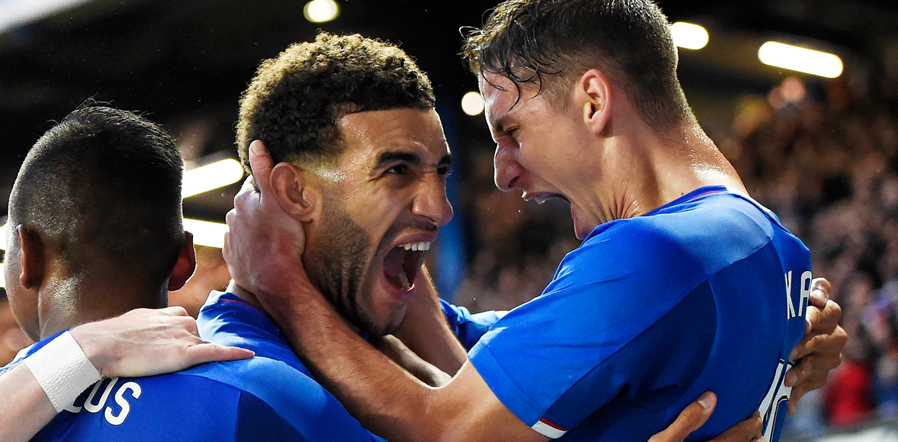This is the second article in this series which aims to describe how Rangers set up tactically. If you haven’t read the first installment which introduced Rangers 2-3-4-1 formation, you can do so here.
In this article I’m going to analyse Rangers centre backs tactical function within this formation. I’ll also look at how our centre backs compare statistically to their peers and identify any strength or weaknesses therein.
What makes a good centre back?
It’s a difficult question and if you speak to any experienced analyst, they will invariably tell you that analysis & scouting for a centre back is a notoriously difficult task. There are a few reasons why, but the main one would be the completely different requirements placed upon centre backs depending on the team they are playing in. For example, a centre half playing for Burnley and a centre half playing for Man City will have completely different skill sets and won’t tend to deviate from these game to game as much as other positions might.
In terms of statistical analysis, there are also more definitive metrics for midfielders & attackers. Passes, key passes, expected assists, expected goals, shots on target all help to paint a picture of the type of player from a creative point of view.
For defenders, it’s trickier. Has the player won 10 tackles in a game because his positioning is suspect or he lacks pace and it’s a last ditch slide tackle? Does he not win as many headers as another centre half because he’s poor in the air or is he playing in a more attacking ball-focused team and he’s involved less?
A centre back’s primary focus is stopping players shooting on target. Stats also now exist which show chances that are given away from a centre backs zone of influence. i.e. if they come from them left or the right side of central defence. Again, it’s not an exact science but you can at least see from which area of the pitch shots are being conceded from.
Different types of centre backs
There are only really three main types of centre backs in the modern game. You have your classic stopper (think Harry Maguire), a ball playing centre back (Aymeric Laporte) and a converted midfielder (Javier Mascherano or Fernandinho) traditional defensive midfielder who has been converted to help primarily with building play from the back.
On very rare occasions, you’ll get a player who could probably be all three; Virgil Van Dijk.
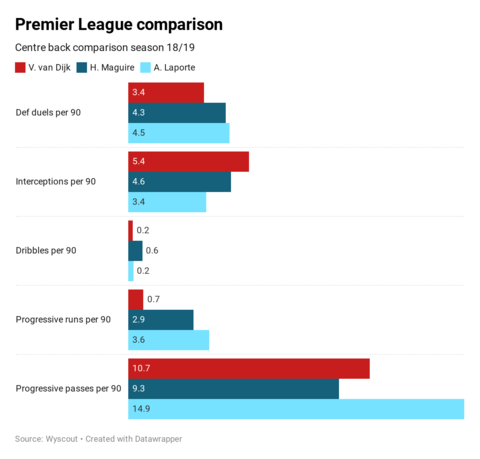
By means of comparison later in the article, I’ve listed some key attributes for a Premier League defender. Please note these figures are from season 18/19 due to Laporte’s lack of minutes through injury in 19/20.
All 3 are generally pretty rounded, but you can see Laporte’s role within Man City’s set up is clearly heavily based on carrying the ball forward into midfield.
How Rangers use their centre backs
That’s why you’re reading this, right? As I mentioned in the previous article, when Rangers are attacking, we do so primarily in a 2-3-4-1 formation with the two centre backs staying back to prevent counter attacks.
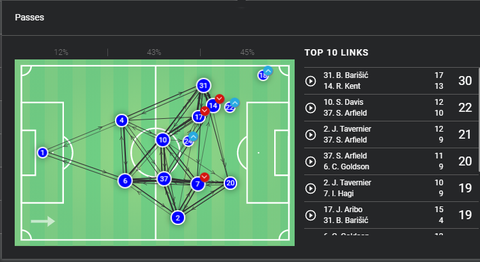
You can see from the image above during the recent 2-1 win vs Hibs that Connor Goldson & George Edmundson are the deepest players in the team. That’s not to say they’re completely absent in the attacking phase of play though, far from it.
To understand more about the strengths and weaknesses of centre backs we can compare them against their peers to see how they stack up.
Let’s firstly look at the number of defensive duels a player is involved in and how successful they are at these.
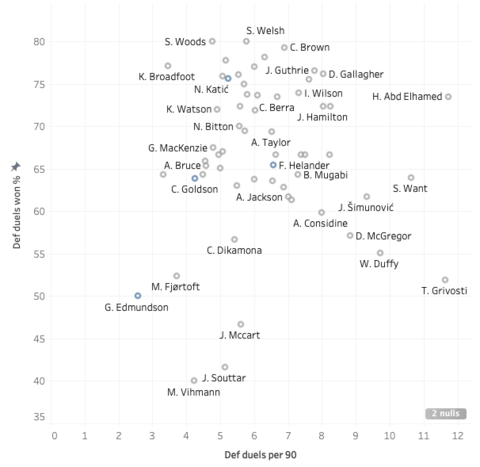
The graph above includes all SPFL Premiership centre backs this season. As mentioned earlier, a higher position here does not necessarily equate to a better defender. The weaker the team, the more defensive duels you are involved in.
The Rangers players are highlighted in blue and we can see that Katic has the highest duel success rate for Rangers – sounds about right. We also see that Helander is involved in the most defensive duels per 90, which may be a surprise to most. given Katic & Goldson are considered more aggressive.
Edmundson ranks the lowest of the three for both defensive duels and success rate. Edmundson is much more of a covering defender so you would expect him to be less involved in duels.
The second aspect I want to explore here are a centre back’s ability on the ball, in terms of both passing and how they carry it.
It’s commonplace in modern football now; the goalkeeper has the ball and the two centre backs ‘split’ to the edge of the box (or inside the box now) ready to receive the ball to build an attack from the back. The desire to control possession has become all consuming.
So, like all tactical evolution, the role of the players changes to accommodate this. Centre backs that kick the ball the way they’re facing and would header their granny are not quite enough now. They need to be comfortable on the ball in order to start attacks quickly and a bit of pace would be lovely too while we’re at it.
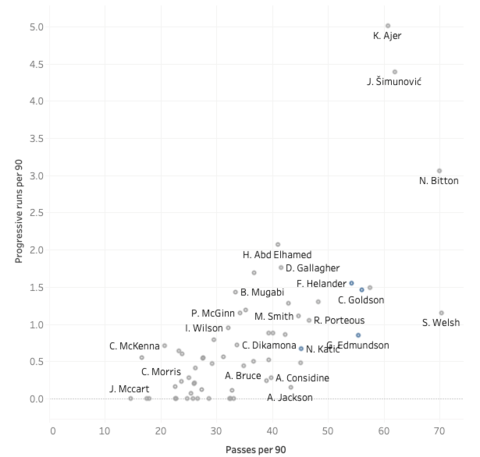
Again, this includes all SPFL Premiership centre backs this season and again, the Rangers players are highlighted in blue.
We see that Goldson attempts the most passes per 90 minutes, with Edmundson & Helander not far behind. Helander makes the most ‘progressive’ runs with just over 1.5 per game whilst Niko Katic is the weakest of the four on these metrics meaning he is less assured with the ball at his feet than the others.
You’ll see the term ‘progressive’ being used throughout this article. This metric is used to determine whether a player makes an action that bypasses the opposition.
If Helander has the ball with 10 defenders between him and the goal and elects to pass through the lines to Scott Arfield, this may now mean that there are 5 defenders between Arfield & the goal. This is classed as a progressive pass as you as progressing towards the opponents goal.
Rangers vs Celtic comparisons
As mentioned earlier, this league of ours is a strange one. Rangers & Celtic play most games in the opposition half and do not regularly face more than two shots on target per game. The skillsets needed are unique – but apply to both teams – so there is some worth in comparing both sets of centre backs to identify strengths & weaknesses.
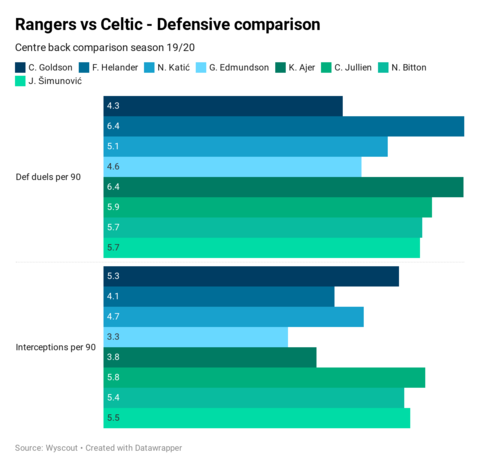
Outside of Niko Katic, Rangers are for the most part involved in defensive duels than their Celtic counterparts. Again, an argument can’t be made for who is better or worse based on this. Our midfield could (and do) do a better job of protecting our centre backs meaning less duels and less interceptions could be a positive overall.

This is where I think many people would see where Rangers centre backs could improve.
Kristoffer Ajer has his faults defensively for me, but he posts some very good numbers in terms of bringing the ball out from the back and helping to initiate attacks from deep.
This is vital against the low block as it engages the first line of pressure and encourages teams to break their shape leaving gaps to exploit. Helander is marginally better than Goldson at this, but there are three Celtic defenders better at it.
Goldson & Edmundson rank on a par on progressive passes so they do a good job of playing through the lines whereas I think most people will know this is not Niko Katic’s wheelhouse so his numbers won’t be too much of a surprise.
Digging into the detail
The image below shows a more detailed view of Rangers centre backs defensively.
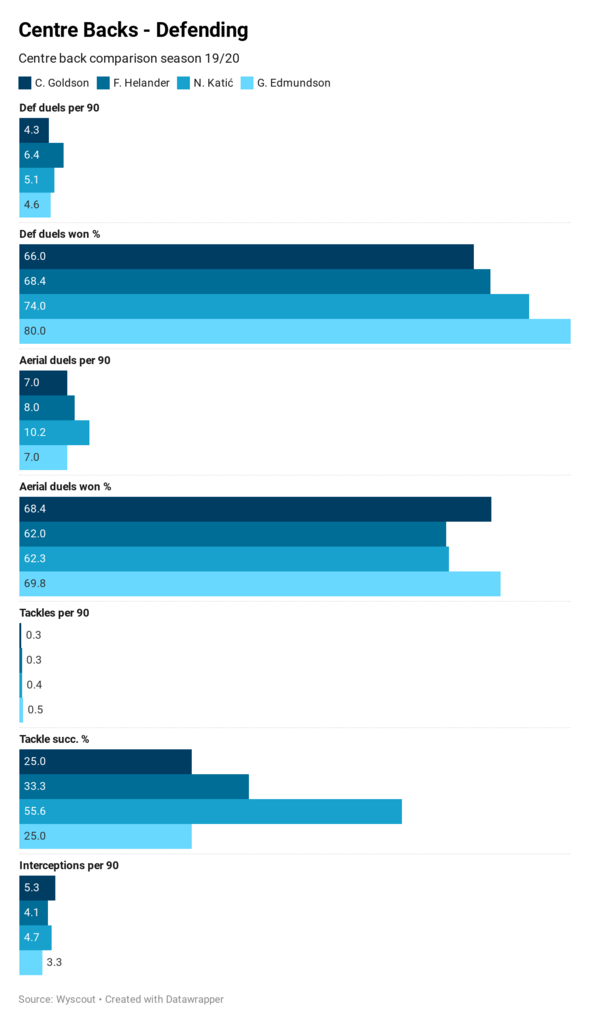
Katic is involved in the most aerial duels which again won’t surprise anyone and whilst Edmundson doesn’t get involved in as many defensive or aerial duels, he has the best success percentage when he does.
In terms of interceptions, Goldson is best with Katic close behind meaning they are able to snuff out danger and intercept a pass before a tackle is required.
Steven Gerrard had this to say last week regarding George Edmundson’s return to the team.
“We just felt for the Hibs game that George was the right man, because he moves the ball well.
What we’ve lacked at times when teams camp in, is the speed of our ball circulation.
Instead of going from A to B, George can get it from A to C. He’s that type of player.”
We can see it’s an area the management team have identified as an area they want to improve, and when you look at the numbers its becomes very clear.
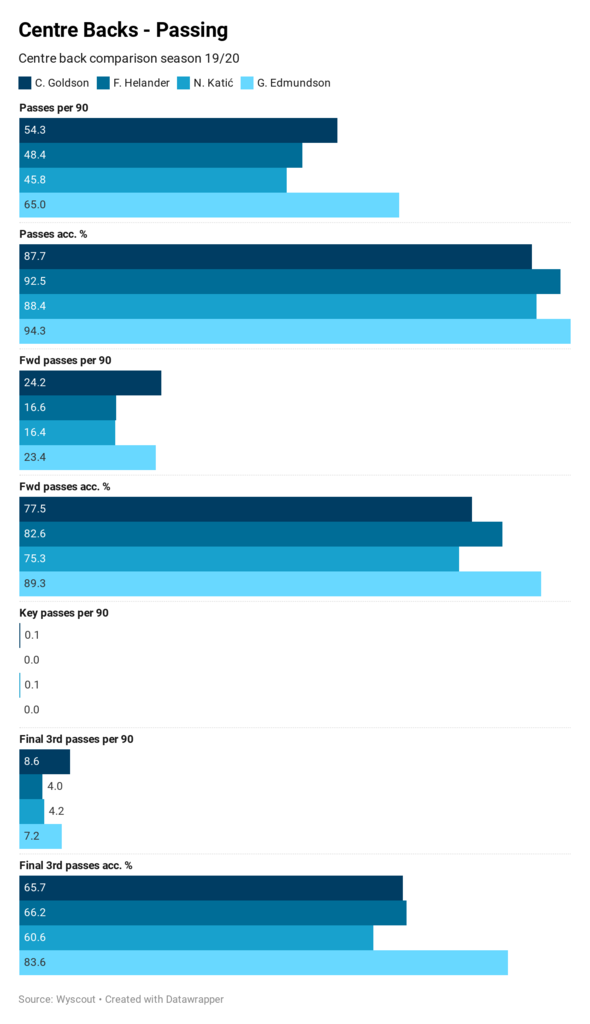
Edmundson and Helander post the highest pass accuracy of the four, particularly impressive in Edmundson’s case is that he makes considerably more passes per game than the other 3.
Of those passes, a sizeable chunk are progressive in that they are not passed sideways or back to McGregor. He contributes to build up play regularly. His long pass accuracy is excellent too, 83% of passes to the final third find their intended target, over 20% more than the other three defenders.
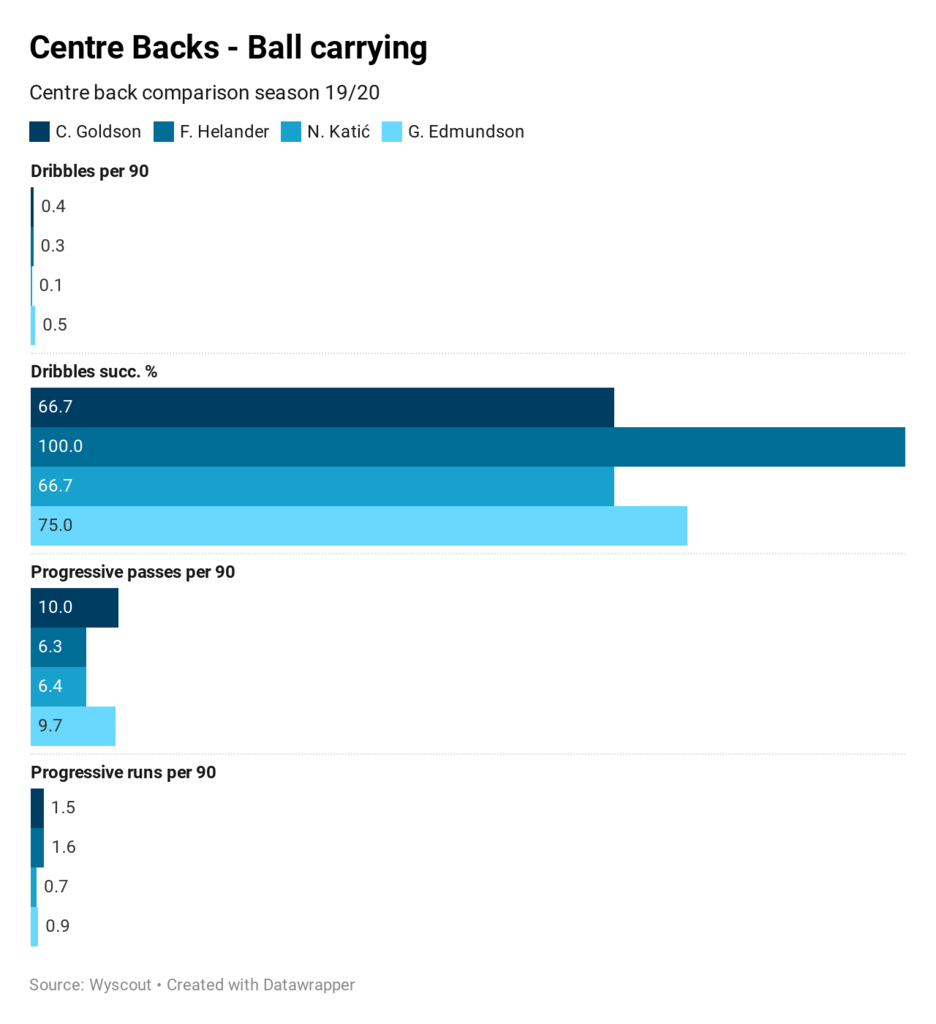
From the numbers above, Filip Helander looks to be the most assured at bringing the ball out from the back. He has a 100% dribble success rate and attempts the most progressive runs per 90 minutes.
Tactical Roles
So, from the above numbers we can discern two distinct tactical roles within the team. A ‘ball playing’ centre back and a more traditional ‘stopper’.
The ball playing centre back is tasked with being a defender first and foremost but also with a vital role to play in initiating attacks and building play from deep whereas the stopper is primarily concerned with stopping the white circular thing from going past the goalkeeper by any means possible.
Connor Goldson is a jack of all trades capable of fulfilling both roles but primarily plays as a ball playing centre back when Niko Katic is in the team.That does him a huge disservice though. Goldson is criminally underated by a large section of the Rangers support. For me, he is our best centre back and the best all rounder in the league.
Filip Helander is similar in style to Connor Goldson but slightly less physical and better at playing out from the back, a nice mix to have.
Niko Katic is your old fashioned throw back, tasked with winning the ball and doesn’t care who or what is in his path. Great to have on some occasions but not in others.
Edmundson is the anti-Katic, not so hugely involved in defensive duels, but comes in to his own when asked to play with the ball at his feet. He is the only one of the four blessed with what you could call pace, too.
Conclusion
The good news is that Rangers have four very competent centre backs and more importantly, have a good mix of skillsets throughout.
The centre backs are frequently in the top 5 passers in the team, so the benefits of them using this possession more intelligently could be significant to the team.
In my opinion, the loss of Filip Helander has had perhaps more of an impact than we realized, due to the excellent results posted in December. His strengths lie in initiating that initial line of pressure and allowing us to shift opponents around at will, something we know we need more of.
Edmundson’s return to the team will help this at all, but we shouldn’t discount Niko Katic as an option. Katic’s defensive strength is significant and will be required regularly over the remainder of the season.
The next article in the series is will focus on another area of the team; Rangers playmaking wing backs

